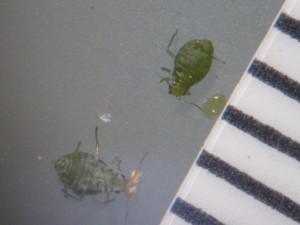http://homernews.com/homer-news/local-news/2015-07-02/aphids-plague-spruce-stands
Category Archives: Forest Health
KDLL Conversation: ‘Hug A Bug’ – Not All Insects Are Pests
Topics included new exotic species, mosquitoes, pollinators, carpenter ants, etc.
Defoliation of spruce by aphids around Kachemak Bay

Aphids from spruce at the Homer Bench, 12.June.2015. Photo courtesy of Karin Sonnen (USDA NRCS, Homer).
Mitch Michaud (USDA NRCS, Kenai), phoned me regarding substantial defoliation of spruce at Halibut Cove and the Homer bench. At Halibut Cove, spruces had been dropping many needles.
Aphids were the culprit, but the identity of the aphids has not yet been established.
Alder (Alnus incana tenuifolia) mortality agent complex effects on riparian zone habitat
The report including this chapter was published in May 2015.
Citation:
Kruse J.J., L. Winton, N. Lisuzzo, G. Adams, K. Zogas, and S. Swenson. 2015. Alder (Alnus incana tenuifolia) mortality agent complex effects on riparian zone habitat. pp. 187-195 in Potter, K. M. and B.L. Conkling, eds. Forest health monitoring: national status, trends, and analysis 2013. General Technical Report SRS-207. U.S. Department of Agriculture Forest Service, Southern Research Station, Asheville North Carolina. http://www.srs.fs.usda.gov/pubs/48361
Large Aspen Tortrix Activity in the Fairbank’s Area
In the last two weeks there have been numerous reports of aspen defoliation in the Goldstream Valley on the north side of Fairbanks. An area approximately 50 acres in size has been heavily defoliated by the caterpillar, large aspen tortrix (Choristoneura conflictana (Walker)). Brief, intense outbreaks are common throughout the range of aspen, and typically last 2-3 years before collapsing. These outbreaks can grow to cover thousands of acres. The larvae tie together leaves with webbing and feed on the plant tissue. They will web other species of plants and feed on them if they run out of available aspen foliage. Although the forest can look very grim, leafless and covered in webbing, the trees will often create a second flush of leaves later in the summer. Historically there has been little long-term damage to the aspen trees associated with past outbreaks.
ADN: Will Alaska’s weird winter be followed by equally strange summer?
The article (URI below) includes interviews with Glenn Juday and Derek Sikes about forest insects, mosquitoes, and yellow jackets.
http://www.adn.com/article/20150322/will-alaskas-weird-winter-be-followed-equally-strange-summer
Forest Health Conditions in Alaska- 2014
The annual forest health conditions report provided by Forest Service R10, Alaska Region is available online (see link to pdf below). The conditions report contains, but is not limited to, information pertaining to forest insects in the state.
“The primary goal of this report is to summarize monitoring data collected annually by our Forest Health Protection team. The report helps to fulfill a congressional mandate (The Cooperative Forestry Assistance Act of 1978, as amended) that requires survey, monitoring, and annual reporting of the health of the forests. This report also provides information used in the annual Forest Insect and Disease Conditions in the United States report.”
http://www.fs.usda.gov/Internet/FSE_DOCUMENTS/stelprd3830191.pdf
Great summer jobs in Forest Health
The US Forest Service, Forest Health Protection has released the outreach information for two seasonal technicians for the 2015 field season, one in Juneau and the other in Cooper Landing.
Information can be found in the notices below
Entomology presentation at the Reforestation Science & Technical Committee Meeting
Nick Lisuzzo provided a pdf version of his presentation from the Reforestation Science & Technical Committee Meeting, November 25, 2014 (Fairbanks, Soldotna, and Anchorage webinar locations).
Forest insects: considerations for successful tree regeneration in South-central and Interior Alaska. Nick Lisuzzo, USDA Forest Service.
2013 Forest Health Conditions Report
The text below was taken verbatim from the Forest Service’s Region 10 (Alaska Region) website at http://www.fs.usda.gov/main/r10/forest-grasslandhealth/. The report is available at http://www.fs.usda.gov/Internet/FSE_DOCUMENTS/stelprd3797075.pdf.
 The 2013 Forest Health Conditions Report is available! This report reviews our current knowledge of forest health in Alaska. Its purpose is to help resource professionals, land managers, and other decision makers identify and monitor existing and potential forest health risks and hazards. The report is based on data collected in annual aerial detection surveys, ground surveys, permanent plot monitoring efforts, follow-ups to public requests, and input, and early detection work. Emphasis is given to damaging agents observed in 2013. Readers need to be mindful that this is not a complete survey of the 127 million forested acres in Alaska. The report is organized around the status of four categories of damaging agents: insect pests, diseases, noninfectious disorders, and invasive plants.
The 2013 Forest Health Conditions Report is available! This report reviews our current knowledge of forest health in Alaska. Its purpose is to help resource professionals, land managers, and other decision makers identify and monitor existing and potential forest health risks and hazards. The report is based on data collected in annual aerial detection surveys, ground surveys, permanent plot monitoring efforts, follow-ups to public requests, and input, and early detection work. Emphasis is given to damaging agents observed in 2013. Readers need to be mindful that this is not a complete survey of the 127 million forested acres in Alaska. The report is organized around the status of four categories of damaging agents: insect pests, diseases, noninfectious disorders, and invasive plants.








